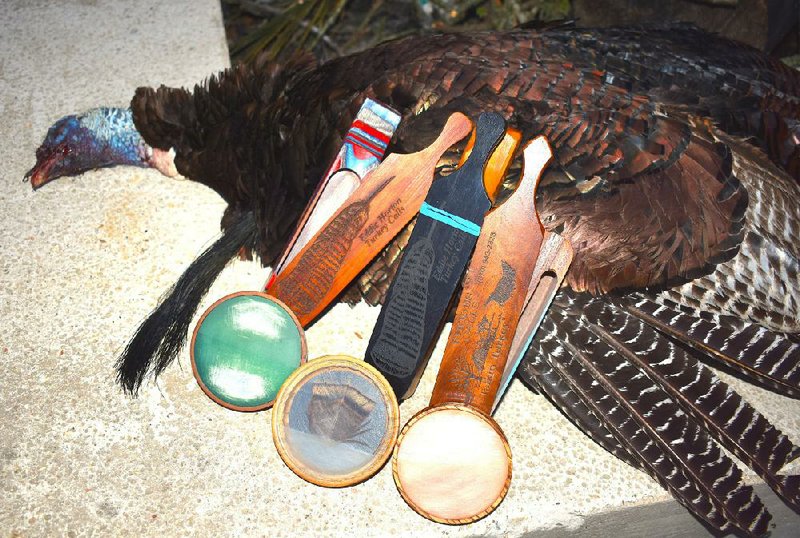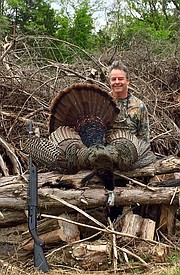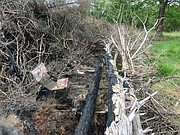A fourth-quarter rally saved my turkey season, and my coach was there to share the victory.
I first hunted turkeys with Mike Stanley, pastor of Friendship Baptist Church in Highland, in 2008, when I was a novice. I killed a few turkeys previously in Missouri and Oklahoma, but unforgiving Arkansas gobblers ruthlessly exposed my inexperience.
Stanley, whom I knew only through a few email exchanges, invited me to hunt with he and his son Michaiah in Sharp County. Mike was a turkey hunting pioneer in Oklahoma in the 1980s. He killed his first turkey in 1984, in Sequoyah County, and he killed his second bird in 1985 in Cherokee County. In 1986, he killed the first turkey ever taken in Adair County. Turkey hunters were few in the '80s, Stanley said, and having killed three birds made him the community expert. He taught the craft to most of the men in his church.
Michaiah, who pastors a church in Seymour, Iowa, is also a seasoned expert who specializes in hunting on public ground.
The Stanleys and I hunted a clever old bird named Woody that was far too wily for me. My errors ensured that none of us killed him. The Stanleys could easily have dismissed me as a noob. Instead, they coached and encouraged me. Mike and I have spent hours talking about turkey hunting, e-mailing about turkey hunting and exchanging text messages about turkey hunting, often while hunting. Whenever I get one, he is the first to know about it.
Arkansas turkeys were unkind to me this season, having abandoned my traditionally productive hunting grounds in Grant County. With time soon to expire, I was desperate to make a play. Stanley called last week to say that a friend in Marion County had invited us to hunt his place. Stanley killed a bird there and said that prospects were good.
At dawn on Monday, we entered a field surrounded by a veritable chorus line of gobblers. We counted at least eight. They were the first gobbles I'd heard in Arkansas this year. Stanley showed me a big cedar tree with an open spot next to the trunk under a protective canopy of branches.
"The way you like to hunt, I almost guarantee a bird will pass by here sometime today," Stanley said, referring to my sit-and-wait philosophy. "I'll be on the hill behind you to see if I can get one to play."
Stanley put out my hen decoy and placed a strutting gobbler decoy nearby.
"It's the first time I've used a decoy this year," Stanley said.
After Stanley vanished into the woods, the pace of the gobbling quickened as the birds prepared to leave their roosts. The gobbler's timbre across the field changed, indicating that it was on the ground. Two on the ridge flew past and landed in the bottom of the field, but I couldn't see them because the slope was too steep. I clucked and purred quietly with an Eddie Horton box call hoping to get some attention.
I worked up a sweat walking to this spot. My facemask funneled my breath onto my glasses and blinded me. I removed my glasses, reasoning that any bird that topped the hill would be close enough to see its beard unaided and determine its legality as an adult gobbler. Minutes later, three red and white heads poked over the ridge at a range of about 30 yards, but their chests were not visible. The birds did not like that gobbler decoy. They stared at it for about five seconds before one bird peeled away and dropped out of sight. The others quickly followed, leaving me sorely disappointed.
For the next hour I gazed at a giant cedar spoil pile in the southeast end of the field. I strongly felt that I needed to be somewhere close to that pile. With the field empty, I stashed the gobbler decoy in some brush, gathered my gear and hastened down the hill. To my great delight, I found an opening in the pile behind a low shield of horizontal cedar limbs that was just big enough for my chair. The spoil rose about eight feet behind, ensuring absolute invisibility. I placed my hen decoy about 15 yards away and waited.
At 9 a.m., what appeared to be a big hawk sailed straight to me from about a quarter of a mile away. It was nearly on top of me when it dropped its tail and landed gracefully beside my decoy. It wasn't a hawk, but a hen turkey. She fed for about 15 minutes and departed.
At about 10 a.m., two jakes entered the field from my left. They ignored the decoy and never paused, but it was a good sign. An adult bird was bound to show up eventually.
At about 11:30 a.m., a gobbler answered my calls from across a creek. For almost two hours he paced back and forth. His path covered about 200 yards, ending about halfway up a distant ridge. I tried every call I knew. He answered them, but he would not cross the creek. Even if he did, he would then have to cross a fence. The odds of calling him across the creek were thin. The odds of then calling him across the fence were near hopeless.
I serenaded him with three box calls and four slate calls using four different strikers. I used two finger yelpers and two mouth calls. Unable to coax the bird across the creek, I played my last card. I scratched a gobble on a dual-slotted cedar box made by my friend Bill Rhodes of Sheridan. The gobbler planted himself directly across the creek. I made contented hen clucks and purrs with a slate and diaphragm, following with the box call gobble. The tom gobbled furiously.
Hearing the commotion, Stanley texted to say he had parked under my old cedar tree. "If he comes over, one of us will kill him," Stanley texted.
Finally, the gobbler's tone changed.
"I call this the plaintive gobble," Stanley texted. "He is in the crossing area. He just hasn't figured out how to get here yet."
Then, Stanley texted to say he had moved to a better ambush point about 150 yards west.
"I haven't called yet," he texted. "I want him to go to you."
And then it got quiet.
"I think he gave us the slip," I texted.
"He never came over that I'm aware of," Stanley replied.
A dark shape materialized from the tall grass. About 100 yards away, a gobbler strolled quickly across the middle of the field. By golly, he crossed the creek and the fence!
"Those gobblers don't read the same magazines that we do," Stanley said.
I stopped the gobbler by striking a long purr on a Premium Game Calls aluminum slate. Only then did the bird seem to notice the decoy. I purred again. The bird gobbled twice and turned toward me. He spread his fan and strutted all the way to the decoy, plumage shimmering in the bright afternoon sunlight. His head glowed brilliant white and blue. His red wattles were aflame. Because of the woody shield in front of me, he did not see me raise my gun.
At about 1:10 p.m., my Winchester put him down at 20 yards. I ran to the bird and knelt in a prayer of gratitude. Whenever I kill a gobbler, I realize that it might a long time before I get another. I am profoundly thankful for each one, but this gobbler staged the finest show of my turkey hunting career. His bottle brush beard was 10 inches. His spurs were only a half-inch long, but he weighed at least 23 pounds.
I lifted my head at an owl hoot from the top of the hill. It was Stanley, arms raised triumphantly.
"I watched it all through binoculars from 400 yards away!" Stanley said. "Man, what a display! I was texting play-by-play to Michaiah the whole time. Congratulations, brother. You earned this one!"
"We earned it," I said. "This right here represents everything you've taught me."
Stanley dubbed the bird "Corona Carl."
Too bad I didn't have a cooler full of Gatorade. I'd have given Stanley a celebratory shower.
Sports on 05/03/2020


